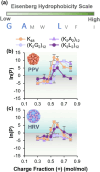Design Rules for the Sequestration of Viruses into Polypeptide Complex Coacervates
- PMID: 38103178
- PMCID: PMC10866146
- DOI: 10.1021/acs.biomac.3c00938
Design Rules for the Sequestration of Viruses into Polypeptide Complex Coacervates
Abstract
Encapsulation is a strategy that has been used to facilitate the delivery and increase the stability of proteins and viruses. Here, we investigate the encapsulation of viruses via complex coacervation, which is a liquid-liquid phase separation resulting from the complexation of oppositely charged polymers. In particular, we utilized polypeptide-based coacervates and explored the effects of peptide chemistry, chain length, charge patterning, and hydrophobicity to better understand the effects of the coacervating polypeptides on virus incorporation. Our study utilized two nonenveloped viruses, porcine parvovirus (PPV) and human rhinovirus (HRV). PPV has a higher charge density than HRV, and they both appear to be relatively hydrophobic. These viruses were compared to characterize how the charge, hydrophobicity, and patterning of chemistry on the surface of the virus capsid affects encapsulation. Consistent with the electrostatic nature of complex coacervation, our results suggest that electrostatic effects associated with the net charge of both the virus and polypeptide dominated the potential for incorporating the virus into a coacervate, with clustering of charges also playing a significant role. Additionally, the hydrophobicity of a virus appears to determine the degree to which increasing the hydrophobicity of the coacervating peptides can enhance virus uptake. Nonintuitive trends in uptake were observed with regard to both charge patterning and polypeptide chain length, with these parameters having a significant effect on the range of coacervate compositions over which virus incorporation was observed. These results provide insights into biophysical mechanisms, where sequence effects can control the uptake of proteins or viruses into biological condensates and provide insights for use in formulation strategies.
Conflict of interest statement
The authors declare no competing financial interest.
Figures






Similar articles
-
Self-Assembling Polypeptides in Complex Coacervation.Acc Chem Res. 2024 Feb 6;57(3):386-398. doi: 10.1021/acs.accounts.3c00689. Epub 2024 Jan 22. Acc Chem Res. 2024. PMID: 38252962 Free PMC article.
-
The effects of protein charge patterning on complex coacervation.Soft Matter. 2021 Jul 14;17(27):6637-6645. doi: 10.1039/d1sm00543j. Soft Matter. 2021. PMID: 34151335
-
Tie line framework to optimize non-enveloped virus recovery in aqueous two-phase systems.J Chromatogr B Analyt Technol Biomed Life Sci. 2019 Sep 15;1126-1127:121744. doi: 10.1016/j.jchromb.2019.121744. Epub 2019 Aug 2. J Chromatogr B Analyt Technol Biomed Life Sci. 2019. PMID: 31437774
-
Protein Encapsulation Using Complex Coacervates: What Nature Has to Teach Us.Small. 2020 Jul;16(27):e1907671. doi: 10.1002/smll.201907671. Epub 2020 May 4. Small. 2020. PMID: 32363758 Review.
-
Complex coacervate-based materials for biomedicine.Wiley Interdiscip Rev Nanomed Nanobiotechnol. 2017 Jul;9(4). doi: 10.1002/wnan.1442. Epub 2016 Nov 4. Wiley Interdiscip Rev Nanomed Nanobiotechnol. 2017. PMID: 27813275 Review.
Cited by
-
Flipping out: role of arginine in hydrophobic interactions and biological formulation design.Chem Sci. 2025 Mar 11;16(16):6780-6792. doi: 10.1039/d4sc08672d. eCollection 2025 Apr 16. Chem Sci. 2025. PMID: 40110519 Free PMC article.
-
Self-Assembling Polypeptides in Complex Coacervation.Acc Chem Res. 2024 Feb 6;57(3):386-398. doi: 10.1021/acs.accounts.3c00689. Epub 2024 Jan 22. Acc Chem Res. 2024. PMID: 38252962 Free PMC article.
-
Biomolecule-Based Coacervation: Mechanisms, Applications, and Future Perspectives in Biomedical and Biotechnological Fields.Biomolecules. 2025 Jun 13;15(6):861. doi: 10.3390/biom15060861. Biomolecules. 2025. PMID: 40563500 Free PMC article. Review.
-
Exploring the effects of excipients on complex coacervation.J Colloid Interface Sci. 2025 Oct;695:137808. doi: 10.1016/j.jcis.2025.137808. Epub 2025 May 5. J Colloid Interface Sci. 2025. PMID: 40359635
References
Publication types
MeSH terms
Substances
Grants and funding
LinkOut - more resources
Full Text Sources

